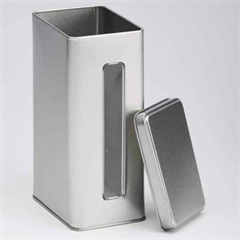When comparing tin boxes to plastic in terms of sustainability, there are several factors to consider, including material sourcing, production processes, durability, recyclability, environmental impact, and end-of-life disposal. Here’s a breakdown of how tin boxes and plastic differ in terms of sustainability:
Tin Boxes:
- Material Sourcing: Tin is a naturally occurring element, and tin boxes are typically made from steel coated with a layer of tin. The extraction of tin is generally less resource-intensive than the extraction of petroleum for plastic production.
- Production: The production of tin boxes involves processes like sheet metal forming and coating with tin. While some energy is required for manufacturing, the processes tend to be less energy-intensive compared to plastic production.
- Durability: Tin boxes are relatively durable and resistant to rust and corrosion. This durability means they have a longer usable life, reducing the need for frequent replacements.
- Recyclability: Tin is fully recyclable, and tin boxes can be collected and recycled in metal recycling streams. Recycling tin has a relatively low energy requirement compared to recycling certain types of plastics.
- Environmental Impact: Tin is considered a relatively environmentally friendly material due to its abundance and recyclability. Its extraction and production have a lower impact on greenhouse gas emissions compared to some plastics.
- End-of-Life: At the end of their life cycle, tin boxes can be recycled into new products, reducing the amount of waste sent to landfills. This contributes to a circular economy where materials are reused rather than discarded.
Plastic:
- Material Sourcing: Plastics are derived from petroleum, a non-renewable fossil fuel. The extraction and processing of petroleum have significant environmental impacts, including habitat disruption and greenhouse gas emissions.
- Production: Plastic production involves energy-intensive processes such as polymerization and molding. These processes contribute to high carbon emissions and energy consumption.
- Durability: While certain plastics are durable, many single-use plastic items have a short lifespan, leading to a high turnover rate and increased waste generation.
- Recyclability: Plastic recyclability varies widely depending on the type of plastic. Some plastics, like PET and HDPE, are more commonly recycled, while others are difficult to recycle or downcycle.
- Environmental Impact: Plastics are associated with a range of environmental issues, including pollution of waterways and ecosystems, wildlife ingestion, and microplastic contamination.
- End-of-Life: Many plastic products are not easily recyclable and often end up in landfills or contribute to marine pollution. Plastics can take hundreds of years to degrade, causing long-lasting environmental harm.
In summary, tin boxes generally offer more sustainability benefits compared to many plastic options. They are made from a natural element, have a lower environmental impact during production, are durable, fully recyclable, and contribute to reducing waste through recycling. However, it’s important to note that the overall sustainability also depends on factors such as transportation, manufacturing practices, and individual recycling efforts. When considering packaging options, choosing tin boxes over certain types of plastic can be a step toward minimizing environmental impact and supporting more sustainable practices.


































